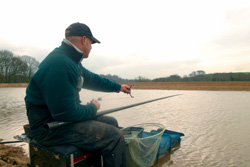Catching shallow is a key tactic on commercial waters through the warmer months, so you need to know how to do it correctly. Match Fishing asked Andy May to reveal some tricks of the trade.
BECAUSE fishing on the bottom is generally seen to be easier than fishing off the bottom, a lot of people plump for the easier option and fish where it’s easier to feed. Fish naturally live at different depths in the water and very rarely, if at all, do they lay with their noses on the lake bed. However, if you’re to make shallow fishing work for you there are a few pointers you should follow. We enlisted the help of Maver and Sensas-backed, shallow fishing master Andy May to show you how to make this deadly summer tactic work.
Knowing When?
Knowing when to target fish shallow is the most important point to consider because although fish do live at all different depths, they won’t always feed up in the water. Now the warmer weather’s here you can catch shallow most of the time and today is great proof of that. All week the temperature has been in the 60s, but this morning the temperature dropped to the low 50s and was accompanied by a strong northeasterly wind making it feel even colder. In fact, we even had some sleet very early on in the morning – typical and I bet it was because the Match Fishing cameras were coming!
The conditions today would lead a lot of people to fish and feed towards catching on the bottom, but I know that it’s still possible to put a big weight together by fishing shallow, providing you go about approaching the swim correctly.
Why Fish Shallow?
If you can get fish feeding up in the water they are generally far more aggressive and will eat bait without considering the dangers first providing your feed is right. That allows you to get away with slightly bigger hooks and heavier terminal tackle, and ultimately catch a bigger weight than if you fish on the bottom. Another strange phenomenon is that bigger fish are often caught shallow, meaning you ultimately have to catch less to win.
Get It Sorted
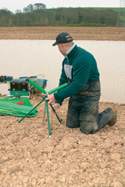 |
| Take time out to position your roller EXACTLY where you need it. |
Because shallow fishing is often about catching quickly, it’s very important to have all your kit in the right place from the outset. Aside from the way you position your seatbox, it is very important you get your pole roller in the right position. If it’s too far back your pole will constantly fall as it leaves the roller, causing tangles to occur that can cost you a lot of time. Similarly, if your roller is too close to you the pole will fall forwards, which will again cause tangles. Even when I’m not fishing too long I will often use two rollers as opposed to one as it allows me to ship far more quickly and reduces the chance of getting into any tangles. I spend a lot of time positioning my roller because having it in the right position will catch me more fish, it’s as simple as that!
Another great piece of kit to use, particularly when it’s windy, is a pole grip of some sort to secure the number 4 sections in place once you’ve shipped back.
On The Whistle
Even when you plan to catch shallow, it’s often wise to start with a bait presented at full depth because the fish are likely to be well spread out in your peg. To start today’s session I introduced three large potfuls of pellets on the nine-metre line, even though I am looking to catch shallow there. The bombardment of bait will draw fish into the peg and it’s then a case of drawing those fish up in the water, which is easy providing you feed very regularly. I will always pot my first feed in from a height to increase the noise it makes, hopefully drawing more fish into the peg. This also gets plenty of feed into the swim, so should help to hold them in your peg for longer.
Bait Choice
By far the best baits for shallow fishing are casters and, where allowed, pellets. These baits make a lot of noise on impact with the water, making them perfect for attracting and holding fish. New waters, like this lake at the Browning Cudmore complex, will respond well to pellets because the fish have been reared on this bait.
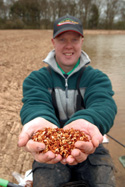 |
| Casters – the essential shallow fishing bait. Make sure you take plenty with you though! |
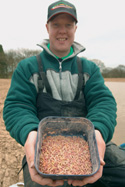 |
| Maggots are far more hardy hook baits than casters, so always make sure you’ve got a few with you |
However, I intend to catch on maggots and casters today. Meat is another very popular bait on commercial waters for catching shallow and a great bonus of meat is that it sinks very slowly, but the downside is that it doesn’t make a lot of noise on impact with the water. Maggots are my favourite hook baits for fishing shallow when feeding casters because they’re quite hardy and will stay on the hook if you miss a bite. A bait that stays on the hook well is important otherwise you’ll be forever shipping in and out rebaiting. Banded pellets are also an excellent bait for shallow fishing because you can usually catch a few fish on one bait and if you miss a bite you simply put the rig in again and carry on feeding – don’t make it hard for yourself.
Ship Shape
Tangles are the most common cause of people giving up shallow fishing. Because you’re often using a rig of less than two feet from pole to hook, keeping everything tangle free is vital. As I’ve said, a pole roller correctly positioned is the most important point, but there are other tricks that’ll increase your shallow fishing success. One tip I do is to ship the pole out under the water.
This allows me to ship very quickly, but I never get any tangles because the pole rig doesn’t have a chance to bounce around. Also, shipping the pole at an angle will prevent the rig wrapping over the pole, which can also happen a lot if you’re not careful. You must keep your rigs simple as well because overcomplicating the shotting will also leave you in a right mess. Shipping out as I do also gives water a chance to enter your pole tip. That’s no bad thing though because once you’ve shipped out, water will constantly drip from the tip recreating the sound of feeding.
Rigs
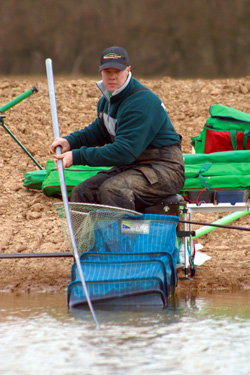 |
| Ship your pole out with the tip submerged underneath the water to prevent tangles |
I only use a couple of different rigs for shallow fishing and all feature spread-out shot. Spreading your shot allows the bait to fall naturally through the water, just like the loose-fed offerings. Usually I’ll not use more than three shots on the rig because as I said, overcomplicating will give you problems. Also, having two or three shot on the line allows me to alter the presentation to suit conditions and the fish’s feeding habits on any day.
I’ve set up two rigs for fishing shallow today. The first is for presenting a bait at two feet deep and comprises a small 0.3g Maver XL carp float, which I have cut down slightly so it’s less obtrusive. This float’s mounted on 0.10mm Maver Genesis line, which I’ve been using for some time now as the diameters are spot on and it’s also very strong for its diameter. The hook is a size 20 Gamakatsu pattern and the rig simply has three No11 shot spread evenly down the line. The second set-up is my bagging rig and that features the same pattern of float, but in a slightly smaller 0.2g size. I have again cut the stem down so it’s less tangle prone and this rig is again made up on 0.10mm Maver Genesis main line. The hook is the same Gamakatsu pattern, but I’ve stepped up to a size 18 because it’s my bagging rig. I’ve shotted this rig with just two No11 shot and I’ve set it to fish a foot deep.
When shallow fishing the bites are generally quite aggressive and fishing a short line from the pole tip to float WILL catch you more fish because it will cause a lot of them to hook themselves against the pole, meaning you’ll lose very few. However, check there’s no restrictions on the waters you fish concerning the length of line from the pole tip to float. Both my rigs feature No10 elastic and I set it as slack as possible to prevent bumping any fish. Although the stamp of fish is small in this lake, this elastic means I can get them out quickly. I always lubricate my elastics too, to ensure they’re as smooth as possible.
The Right Technique
Being able to feed with a catapult while holding a pole is very important to being a successful shallow angler because you’ll be able to catch far more fish than you would if you were to put your pole down every time you feed. It’s also important to be able to strike when you’re feeding, meaning the right pole-holding technique is crucial. I like to rest my pole across both knees and simply lift my heel to raise the pole tip and strike. The best anglers all make it look effortless, but it only takes time and practice.
I see a lot of people who strike far too hard when they’re shallow fishing and that can present a few problems.
Firstly you’re not going to hit every bite you get, so by striking hard it’s likely you’ll end up in some horrendous tangles, slowing down your catch rate. Striking hard is not essential because I’m fishing with a short rig and a short line from pole tip to float anyway, meaning only the smallest movement will set the hook. Also, striking hard will cause small fish to splash on the surface, which often spooks every other fish there and this is definitely not what you want.
Feeding
I have come across an easy way to load and feed a catapult and that’s as follows. Simply hold the pouch in your right hand, grab the
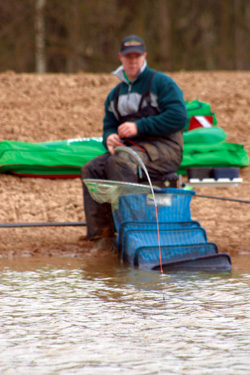 |
| The ability to strike while feeding is essential if you’re to be successful at this game |
bait with your left and fill the pouch. Hold the frame with your left hand and instead of pulling back, push the frame forwards and let go of the pouch, all the time being ready to strike.
Once I’ve fed I’ll usually lift the bait and let it drop through the water again with the feed, and bites are usually instant.
For a typical shallow session I’ll take four pints of casters and a handful of maggots for hook baits. Caster hook baits can get shelled very quickly, where as a maggot is far tougher and you can often catch five or six fish on one hook bait, which is a bonus when you’re catching quickly.
Now, feeding is the area that’s essential to get right and it’s unfortunately the area most people seem to get wrong. Catching up in the water requires very regular feeding and today I’m feeding just eight to 10 casters every 10 seconds. This creates a constant splash on the surface that draws fish into the peg right where I want to catch them. Sometimes you need to feed more bait, especially when they’re bigger fish or there are more in the peg. Feeding a lot of bait regularly is sometimes useful to get a lot of fish in the peg, then once they’re there you can cut down the amount to increase the chance of fish taking the hook bait.
Get out there and give it a go, you’ll be amazed how many fish are there to be caught shallow!
Hot Tip
A permanent marker will allow you to change your tip colour to suit different light conditions.
VENUE FILE
Cudmore Fishery
Location: Newcastle-under-Lyme, Staffordshire
How to get there: Leave the M6 at junction 15 and take the A5182 heading west to join the A53. At Whitmore, turn right into Plecks Lane. The fishery is on the right after around a mile.
Controlled by: Privately owned
Contact for club bookings: Frank Clarke or Vic Spooner on 01782 680919
Contact for open matches: Frank Clarke or Vic Spooner on 01782 680919
Rules: No trout pellets; barbless hooks only; keepnets are only allowed in matches and at the managements’ discretion; all nets are to be dipped; all groundbait, pellets and hemp must be purchased on site


